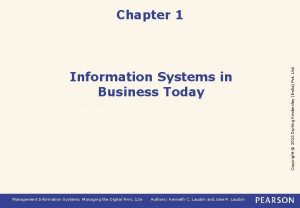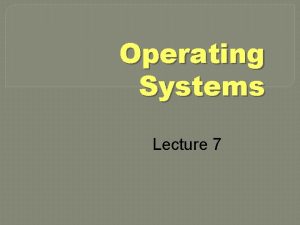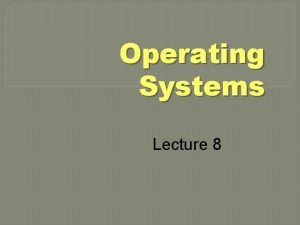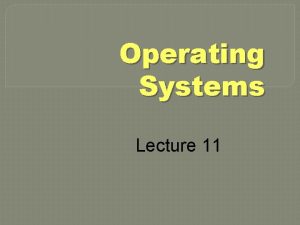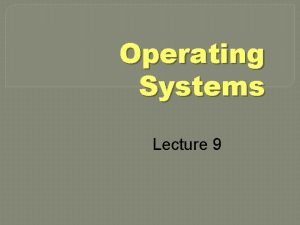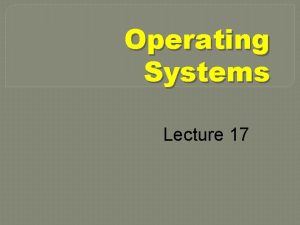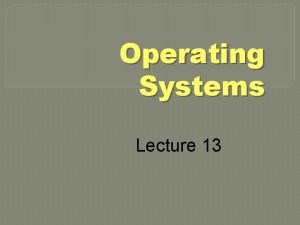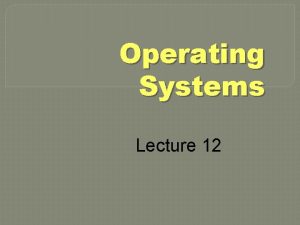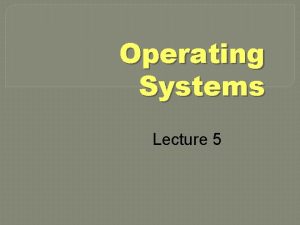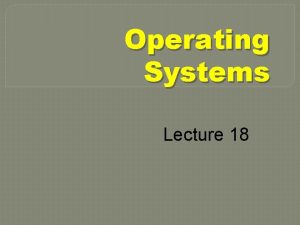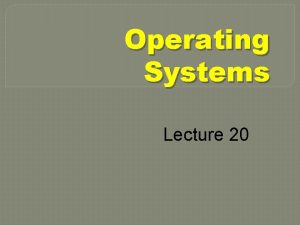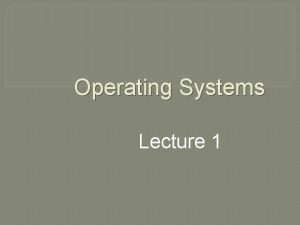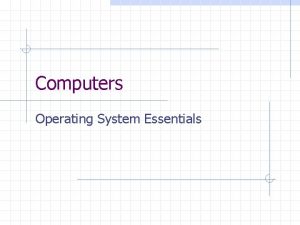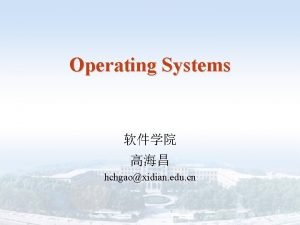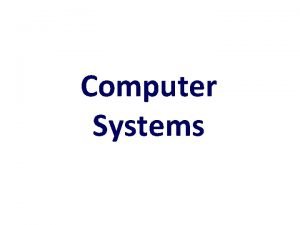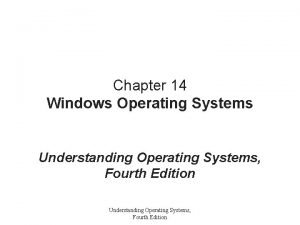Operating Systems Lecture 10 Agenda for Today Review





![Input Redirection $ [ $ cat < Phones contents of Phones ] grep “Nauman” Input Redirection $ [ $ cat < Phones contents of Phones ] grep “Nauman”](https://slidetodoc.com/presentation_image/2eeacd808393d66afbf39e5f99422e9c/image-6.jpg)

![Output Redirection $ cat > Phones [ your input ] <Ctrl-D> $ grep “Ali” Output Redirection $ cat > Phones [ your input ] <Ctrl-D> $ grep “Ali”](https://slidetodoc.com/presentation_image/2eeacd808393d66afbf39e5f99422e9c/image-8.jpg)












- Slides: 20

Operating Systems Lecture 10

Agenda for Today Review of previous lecture Input, output, and error redirection in UNIX/Linux FIFOs in UNIX/Linux Use of FIFOs in a program and at the command line Recap of lecture

Review of Lecture 9 UNIX/Linux IPC tools and associated system calls UNIX/Linux standard files and kernel’s mechanism for file access Use of pipe in a program and at the command line

Input, Output, Error Redirection You can use the Linux redirection features to detach the default files from stdin, stdout, and stderr and attach other files with them.

Input Redirection: command < input-file command 0< input-file Purpose: Detach keyboard from stdin and attach ‘input-file’ to it, i. e. , ‘command’ reads input from ‘input-file’ and not keyboard
![Input Redirection cat Phones contents of Phones grep Nauman Input Redirection $ [ $ cat < Phones contents of Phones ] grep “Nauman”](https://slidetodoc.com/presentation_image/2eeacd808393d66afbf39e5f99422e9c/image-6.jpg)
Input Redirection $ [ $ cat < Phones contents of Phones ] grep “Nauman” < Phones output of grep ]

Output Redirection: command > output-file command 1> output-file Purpose: Detach the display screen from stdout and attach ‘output-file’ to it, i. e. , ‘command’ sends output to ‘output-file’ and not the display screen
![Output Redirection cat Phones your input CtrlD grep Ali Output Redirection $ cat > Phones [ your input ] <Ctrl-D> $ grep “Ali”](https://slidetodoc.com/presentation_image/2eeacd808393d66afbf39e5f99422e9c/image-8.jpg)
Output Redirection $ cat > Phones [ your input ] <Ctrl-D> $ grep “Ali” Phones > Ali. phones [ output of grep ] $ find ~ -name foo -print > foo. log [ error messages ] $

Error Redirection: command 2> error-file Purpose: Detach the display screen from stderr and attach ‘errorfile’ to it, i. e. , error messages are sent to ‘error-file’ and not the display screen

Error Redirection $ find ~ -name foo -print 2> errors [ output of the find command ] $ ls -l foo 2> error. log [ output of the find command ] $ cat error. log ls: foo: No such file or directory $ find / -name ls -print 2> /dev/null /bin/ls $

UNIX/Linux FIFOs IPC for communication between related or unrelated processes on a computer P 1 P 2 FIFO UNIX/Linux System

UNIX/Linux FIFOs A file type in UNIX Created with mknod() or mkfifo() system call or by mkfifo command

UNIX/Linux FIFOs Unlike a pipe, a FIFO must be opened before using it for communication A write to a FIFO that no process has opened for reading results in a SIGPIPE signal

UNIX/Linux FIFOs When the last process to write to a FIFO closes it, an EOF is sent to the reader Multiple processes can write to a FIFO atomic writes to prevent interleaving of multiple writes

UNIX/Linux FIFOs Two common uses of FIFOs In client-server applications, FIFOs are used to pass data between a server process and client processes Used by shell commands to pass data from one shell pipeline to another, without creating temporary files

Client-Server Communication with FIFOs

Creating FIFOs mknod system call Designed to create special (device) files mkfifo Command mkfifo C library call Invokes mknod system call

Command Line Use of FIFOs $ $ $ [ $ mkfifo 1 prog 3 < fifo 1 & prog 1 < infile | tee fifo 1 | prog 2 Output ]

Command Line Use of FIFOs $ man ls > ls. dat $ cat < fifo 1 | grep ls | wc -l & [1] 21108 $ sort < ls. dat | tee fifo 1 | wc -l 31 528 grep Pipe wc -l fifo 1 $ infile sort tee Pipe wc -l

Recap of Lecture Review of previous lecture Input, output, and error redirection in UNIX/Linux FIFOs in UNIX/Linux Use of FIFOs at the command line Recap of lecture
 Operating system lecture notes
Operating system lecture notes 01:640:244 lecture notes - lecture 15: plat, idah, farad
01:640:244 lecture notes - lecture 15: plat, idah, farad Agenda sistemica y agenda institucional
Agenda sistemica y agenda institucional Agenda for today
Agenda for today Today meeting or today's meeting
Today meeting or today's meeting Are we having class today
Are we having class today Proposal kickoff meeting agenda
Proposal kickoff meeting agenda Galton details
Galton details Today's lesson or today lesson
Today's lesson or today lesson Today's lesson or today lesson
Today's lesson or today lesson Project review agenda
Project review agenda Management review agenda
Management review agenda Articulators
Articulators Lecture sound systems
Lecture sound systems Agenda management systems
Agenda management systems Agenda open systems
Agenda open systems Levels of management information system
Levels of management information system Global business today chapter 1
Global business today chapter 1 Information systems in global business today
Information systems in global business today Information systems in global business today
Information systems in global business today Information system in global business today
Information system in global business today
















